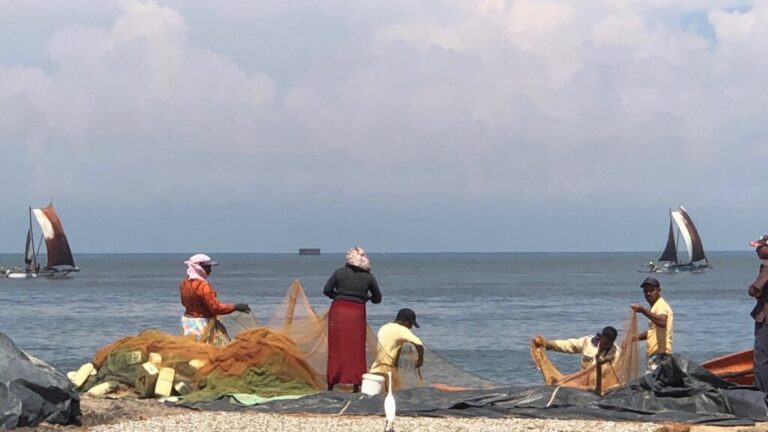The ancient city of Polonnaruwa in central Sri Lanka is a shining place of palaces and shrines. I particularly admire the superb inscription left by one haughty ruler, informing an envious rival that he is like a jackal wanting to be a lion, a worm, a cobra, a sheep, a horse, a firefly, the sun. That’s one heck of a putdown.
These royal ruins — a UNESCO World Heritage Site dating back to the tenth century — are sprawling, staggering and world-class. Yet they are almost deserted.
It’s the same story all over the country. Gleaming hotels, empty. Glittering beaches, abandoned. Gripping museums, echoing with the absence of visitors.
Why? Because on April 21, Islamist suicide bombers with links to ISIS walked into three hotels and three Catholic churches and detonated devices, killing 259 people and injuring another 500.
Sri Lanka’s visitor numbers plummeted, and the tenth of the population that relies on tourism has suffered its worst year in memory.
I speak to Wasantha, 42, a soft-voiced souvenir vendor at Polonnaruwa who, from boyhood, has sold his cobra flutes and palm-leaf hats to visitors. Recently he took out a loan to buy a small guesthouse, but since April he has had to default on repayments. His message to foreigners is simple: ‘Our country needs you.’
The sad-eyed owner of an excellent nearby restaurant, Lasantha, 48, has pawned his wife’s jewellery to pay his staff to wait on empty tables.
It’s not surprising the bombings have affected tourism. But we’re now seven months on and the Foreign & Commonwealth Office has lifted its ban on casual visits. So where is everybody?
They’ll be back. But for the time being, you can enjoy everything this wonderful island in the Indian Ocean has to offer — and you can have most of it to yourself.
When I go snorkelling on the coral reefs off Trincomalee in the east, I’m the only client in the 20-seat motorboat.
‘There are many sharks here,’ says the boatman, Kaleel, as I wrestle with my flippers. ‘Would you like to see them?’
Sure, the blacktip reef sharks I swim with are small, about 4ft long. But their silhouettes look pretty disturbing as they pass by, grey and ghostlike.
Again, I’m almost alone when I reach the rock temple at Gal Vihara, and gaze on the four mighty statues of the Buddha. They’re among the most beautiful things I’ve ever seen, particularly the last of them, lying down, eyes closed, his hand seeming to cup his ear.
‘Not sleeping,’ the elderly attendant with the pencil moustache tells me. ‘Nirvana.’
I try a joke (‘He’s listening to Nirvana?’), but the old boy doesn’t seem to hear. By now my mood is as calm as a bodhisattva and I let it go.
Of course, I know my inner peace, born of blissful near-solitude, is at the cost of pain for millions of Sri Lankans.
‘In July and August, we had 350 tours booked,’ says my driver guide, Harold. ‘All of them were cancelled. English market, German market, Dutch market. All.’
The charming Harold, 51, who is married with three sons to support, has had to accept help from his boss to pay his rent. His wife has gone to work, in a factory, for the first time since they married. ‘My oldest son is working,’ he says, ‘but he earns a very small salary. So four people depend on me.’
While we drive towards Jaffna, Harold’s mobile rings with good news: his middle son, 20-year-old Jeewantha, has been offered a job as a trainee pastry chef at the Shangri-La Hotel in Colombo.
But isn’t that one of the hotels that was blown up in April? ‘Yes.’ And isn’t he worried about the boy’s safety? He isn’t, and he explains why.
Sri Lanka is a mainly Buddhist nation, ethnically Sinhalese. Historically, the strife — most notably in the civil war that blighted the country from 1983 to 2009 — has always been between this majority and the Tamil minority in the north, most of whom are Hindu. There are also Muslim and Christian minorities, but, broadly speaking, these are a peaceful presence in the country, neither hating nor hated.
Even during the war, bombs were aimed at government buildings, never at Christian churches, let alone hotels. The point is, there is no pattern of targeting tourist areas. ‘The attacks that happened this April were a one-off,’ says Harold
It’s confirmed wherever I go: in 2019, things have been tougher for tourism even than during the civil war.
‘It’s the worst period in 40 years,’ says Prasath, 58, the boatman who takes me on a tour of the lagoon at Negombo. This is one of the places that was bombed, but the pageant of brightly coloured fishing boats makes it easy to forget.
It’s my first morning, yet in a couple of hours on the uncrowded water I see enough to justify my entire trip: idle iguanas, macaque monkeys busy among the mangroves, fat fruit bats hanging like black lanterns from the taller trees.
On my last morning, I stop in at the Shangri-La Hotel for a cup of coffee. Since it was hit in April, the place has been restored to its former pristine condition: you wouldn’t know anything had happened here. A slim and smiley boy, the hotel’s newest pastry chef, asks me to write that Sri Lanka is ‘the best country in the world to travel to’.
I’m happy to say so. What’s more, new developments set to open in 2020 include the Pekoe House hotel in Kandy and a new Alila hotel at Koggala in the south. High season starts in November, so it’s not too late to book some winter sun. And you really should. This country needs you.

